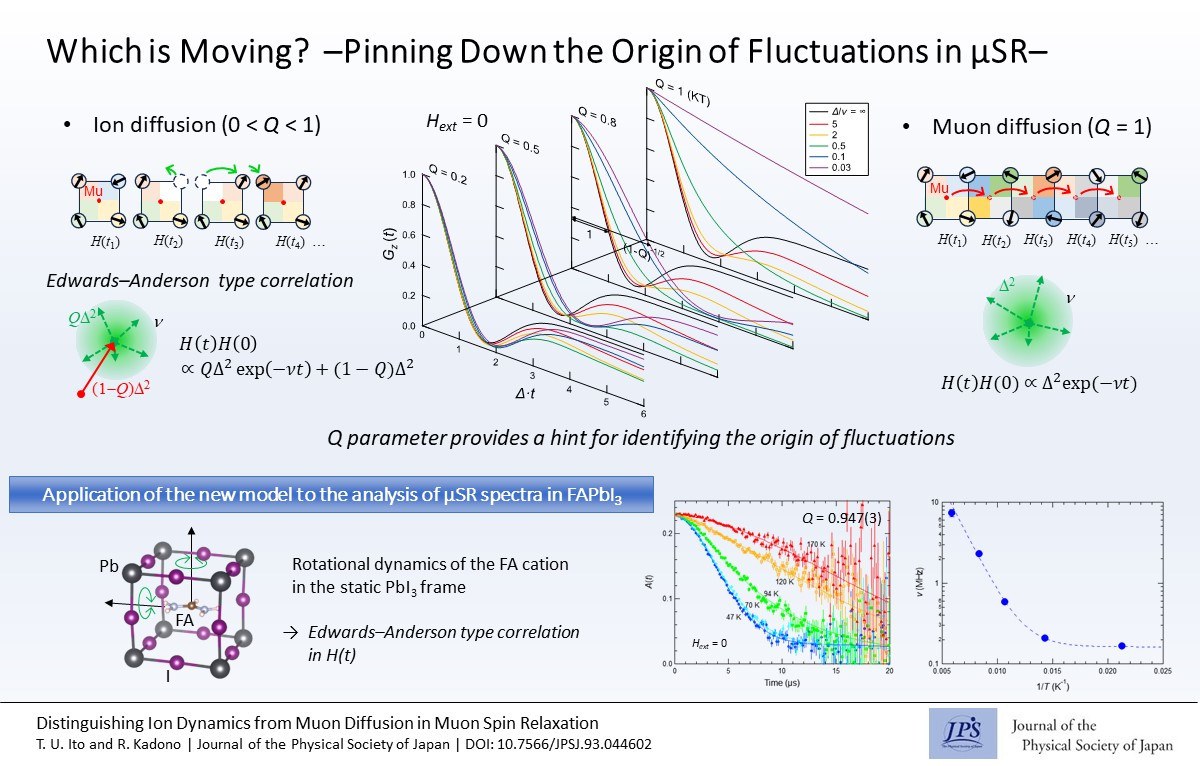Which is Moving?—Pinning Down the Origin of Fluctuations in Muon Spin Relaxation—
© The Physical Society of Japan
This article is on
Distinguishing Ion Dynamics from Muon diffusion in Muon Spin Relaxation
(JPSJ Editors' Choice)
J. Phys. Soc. Jpn. 93, 044602 (2024).
The study demonstrated that we can distinguish between the diffusion motion of the muon itself and the motion of the surrounding ions in muon spin relaxation.

In the muon spin relaxation (µSR) measurements, the distribution (described by linewidth D) of internal magnetic field H(t) and its temporal fluctuations (with mean fluctuation rate n) can be observed by implanting spin-polarized muons into a material. However, distinguishing whether the fluctuations are caused by the diffusive motion of the muon itself or the motion of the ions around it, is difficult. In this study, by reviewing the strong collision model, which is an assumption used to describe spin relaxation, we observed that the difference in the cause of the fluctuation appeared as a difference in the spin relaxation function. The new model reproduces well the spin relaxation owing to the local rotational motion of cation molecules observed in hybrid perovskites; this opens the way to distinguish the cause of fluctuations solely from the µSR data.
When a muon exhibits jump-diffusion in a nonmagnetic material, the configuration of the nuclear magnetic moments around the muon changes simultaneously before and after the site change. The fluctuation of H(t) owing to these jumps is well approximated by the strong collision model [where the autocorrelation of H(t) is given by equation H(t)H(0)~D2exp(-nt)], and the time evolution of the muon spin polarization, Gz(t), is described by the dynamical Kubo–Toyabe (KT) relaxation function. However, if the H(t) fluctuations are due to the jump diffusion of ions, only a part of the ion configuration around the muon changes in one jump, and the strong collision model is not necessarily expected to be applicable.
Therefore, we performed Monte Carlo simulations for Gz(t) using a model in which the fluctuations of H(t) owing to ion motion were described by an Edwards–Anderson type autocorrelation function with the quasi-static and dynamic components of the autocorrelation separated by parameter Q [where H(t)H(0)~QD2exp(-nt) + (1-Q)D2], and Gz(t) was noted to deviate significantly from the KT function. To further verify this model, we compared the µSR spectra observed in the hybrid organic–inorganic perovskite FAPbI3 [FA refers to HC(NH2)2] with the simulation results. The least-squares curve fitting results showed excellent agreement with the model with Q = 0.947(3), yielding reasonable fluctuation frequencies for the dynamical component. This result opens the possibility of experimentally distinguishing between fluctuations owing to the dynamics of ions around muons and fluctuations owing to the self-diffusion of muons.
Written by T. U. Ito and R. Kadono
Distinguishing Ion Dynamics from Muon diffusion in Muon Spin Relaxation
(JPSJ Editors' Choice)
J. Phys. Soc. Jpn. 93, 044602 (2024).
Share this topic
Fields
Related Articles
-
Evaluation of the Exchange Stiffness Constants of Itinerant Magnets from the First-Principles Calculations
Electron states in condensed matter
Structure and mechanical and thermal properties in condensed matter
2024-6-5
Using first-principles calculations, we evaluated the exchange stiffness constants of ferromagnetic metals at finite temperatures. The constants can be used as parameters in the Landau–Lifshitz–Gilbert equation.
-
Variety of Mechanically Induced Spin Currents in Rashba Systems
Electronic transport in condensed matter
Magnetic properties in condensed matter
Structure and mechanical and thermal properties in condensed matter
2024-3-22
Various types of spin currents, including unconventional types, are generated in Rashba spin-orbit coupled systems by dynamic lattice distortions associated with, for example, surface acoustic waves.
-
Relation between Mean-Field Theory and Atomic Structures in Chalcogenide Glasses
Structure and mechanical and thermal properties in condensed matter
2024-2-1
The authors conducted various of X-ray and neutron scattering experiments on typical chalcogenide glasses and clarified the relationship between the atomic structure and simple rigidity percolation theory.
-
Thermodynamic Property of a CMOS Device beyond Landauer Limit
Statistical physics and thermodynamics
Electronic transport in condensed matter
Cross-disciplinary physics and related areas of science and technology
2024-1-23
Focusing on a CMOS NAND GATE operating in a sub-threshold region, the thermodynamic cost of computation was analyzed in relation to input/output voltages surpassing the Landauer limit.
-
Possible Origin of High Thermoelectric Power Factor in Ultrathin FeSe: A Two-band Model
Electronic structure and electrical properties of surfaces and nanostructures
Structure and mechanical and thermal properties in condensed matter
Cross-disciplinary physics and related areas of science and technology
2023-12-21
The high thermoelectric power factor observed in ultrathin FeSe can be theoretically explained by a two-band model with chemical potential between upper and lower band bottoms.
